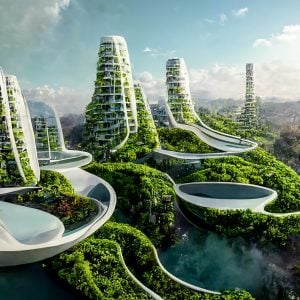
Building Tomorrow: Speculating on the Future of Architecture
The world of architecture has always been a reflection of human ingenuity, innovation, and the evolving needs of society. As we stand on the precipice of the third decade of the 21st century, the future of architecture appears poised to embrace unprecedented changes and challenges. From floating cities to Mars colonies, let’s embark on a journey of speculation and exploration into the futuristic concepts that might shape the architecture of tomorrow.
Floating Cities
Imagine waking up in a city that floats on the surface of the ocean. Floating cities have been a dream of futurists for years, and the concept is becoming increasingly plausible. Rising sea levels and overpopulation in coastal areas have spurred interest in creating self-sustaining floating communities. These cities could utilize advanced materials and technologies to harness renewable energy, purify seawater, and grow food, making them entirely self-sufficient.
Architects would need to design structures that can withstand the challenges of constant movement and the harsh marine environment. These cities could not only provide refuge from rising sea levels but also offer a unique and sustainable way of life.
Vertical Forests and Skybridges
In densely populated urban areas, space is at a premium. The concept of vertical forests, where skyscrapers are adorned with lush greenery, has gained traction. These “green buildings” not only improve air quality but also provide a respite from concrete jungles. Furthermore, architects are exploring the idea of connecting these skyscrapers with skybridges, creating elevated networks that redefine urban mobility.
Imagine walking from your office on the 35th floor to your apartment on the 40th floor, all while enjoying breathtaking views of the city and breathing in fresh, oxygen-rich air. These vertical forests and skybridges could be the future of urban living, blending nature with the cityscape.
Lunar and Martian Colonies
The idea of establishing colonies on the Moon and Mars is no longer confined to science fiction. Space agencies and private companies are actively working on plans for extraterrestrial colonization. Architects are central to these endeavors, as they must design habitats that can protect humans from the harsh environments of space.
These habitats would need to be airtight, radiation-resistant, and capable of providing life support systems. The architecture of lunar and Martian colonies could be a blend of functional design and cutting-edge technology. Paving the way for a new era of human exploration.
3D-Printed Buildings
3D printing technology has already made its mark in the world of architecture, with projects ranging from houses to bridges. However, the future holds the promise of even more ambitious endeavors. Imagine entire buildings being 3D-printed in a matter of days or weeks, using sustainable materials like recycled plastics or lunar and Martian regolith.
This technology could revolutionize the construction industry, making housing more affordable and sustainable. Architects would play a pivotal role in designing the blueprints for these 3D-printed structures. Pushing the boundaries of what’s possible in terms of form and function.
Adaptive and Smart Cities
The cities of the future will be smarter and more adaptive than ever before. Integrated sensors, artificial intelligence, and data analysis will enable cities to respond in real-time to changing conditions such as traffic congestion, weather patterns, and energy consumption. Architects will need to design buildings and infrastructure that can seamlessly integrate these technologies.
Imagine buildings that adjust their energy usage based on occupancy or weather forecasts, or streets that automatically reroute traffic to ease congestion. Smart and adaptive cities will not only enhance the quality of life for residents but also reduce environmental impact.
Conclusion
The future of architecture is an exciting frontier filled with limitless possibilities. From floating cities on the oceans to colonies on other planets, from vertical forests in urban jungles to 3D-printed buildings and smart cities, architects will play a pivotal role in shaping the world of tomorrow.
As technology advances and our understanding of sustainability deepens, the architecture of the future will be a testament to human creativity and our ability to adapt to ever-evolving challenges. Whether on Earth, the Moon, or Mars, the buildings and cities of the future will reflect our dreams, our needs, and our determination to build a better world.






